Related Research Articles

A pegmatite is an igneous rock showing a very coarse texture, with large interlocking crystals usually greater in size than 1 cm (0.4 in) and sometimes greater than 1 meter (3 ft). Most pegmatites are composed of quartz, feldspar, and mica, having a similar silicic composition to granite. However, rarer intermediate composition and mafic pegmatites are known.

The mineral group tantalite [(Fe, Mn)Ta2O6] is the primary source of the chemical element tantalum, a corrosion (heat and acid) resistant metal. It is chemically similar to columbite, and the two are often grouped together as a semi-singular mineral called coltan or "columbite-tantalite" in many mineral guides. However, tantalite has a much greater specific gravity than columbite (8.0+ compared to columbite's 5.2). Iron-rich tantalite is the mineral tantalite-(Fe) or ferrotantalite and manganese-rich is tantalite-(Mn) or manganotantalite.

Lithiophilite is a mineral containing the element lithium. It is lithium manganese(II) phosphate with chemical formula LiMnPO4. It occurs in pegmatites often associated with triphylite, the iron end member in a solid solution series. The mineral with intermediate composition is known as sicklerite and has the chemical formula Li(Mn,Fe)PO4). The name lithiophilite is derived from the Greek philos (φιλός) "friend," as lithiophilite is usually found with lithium.
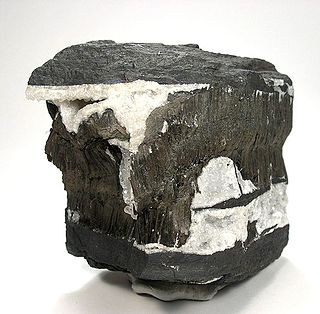
Todorokite is a complex hydrous manganese oxide mineral with generic chemical formula (Na,Ca,K,Ba,Sr)
1-x(Mn,Mg,Al)
6O
12·3-4H
2O. It was named in 1934 for the type locality, the Todoroki mine, Hokkaido, Japan. It belongs to the prismatic class 2/m of the monoclinic crystal system, but the angle β between the a and c axes is close to 90°, making it seem orthorhombic. It is a brown to black mineral which occurs in massive or tuberose forms. It is quite soft with a Mohs hardness of 1.5, and a specific gravity of 3.49 - 3.82. It is a component of deep ocean basin manganese nodules.

Frank Christopher Hawthorne is a Canadian mineralogist, crystallographer and spectroscopist. He works at the University of Manitoba, Winnipeg, Manitoba, Canada, and is currently Distinguished Professor Emeritus. By combining Graph Theory, Bond-Valence Theory and the moments approach to the electronic energy density of solids he has developed Bond Topology as a rigorous approach to understanding the atomic arrangements, chemical compositions and paragenesis of complex oxide and oxysalt minerals.

Seamanite, named for discoverer Arthur E. Seaman, is a rare manganese boron phosphate mineral with formula Mn3[B(OH)4](PO4)(OH)2. The yellow to pink mineral occurs as small, needle-shaped crystals. It was first discovered in 1917 from a mine in Iron County, Michigan, United States and identified in 1930. As of 2012, seamanite is known from four sites in Michigan and South Australia.

Cyrilovite (NaFe33+(PO4)2(OH)4·2(H2O)) is a hydrous sodium iron phosphate mineral. It is isomorphous and isostructural with wardite, the sodium aluminium counterpart.
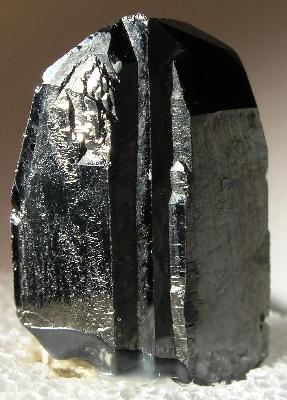
Wodginite is a manganese, tin, tantalum oxide mineral with the chemical formula Mn2+(Sn,Ta)Ta2O8. It may also include significant amounts of niobium.
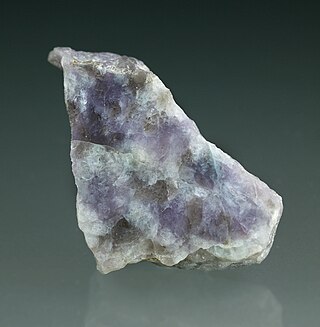
Rubicline, also referred to as Rb-microcline, is the rubidium analogue of microcline, an important tectosilicate mineral. Its chemical formula is (Rb, K)[AlSi3O8] with an ideal composition of RbAlSi3O8. Chemical analysis by electron microprobe indicated the average weight of the crystal is 56.66% SiO2, 16.95% Al2O3, and 23.77% Rb2O, along with trace amounts of caesium oxide (Cs2O) and iron(III) oxide (Fe2O3).
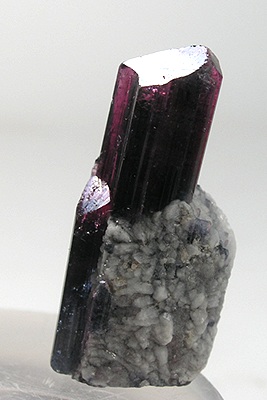
Fluor-liddicoatite is a rare member of the tourmaline group of minerals, elbaite subgroup, and the theoretical calcium endmember of the elbaite-fluor-liddicoatite series; the pure end-member has not yet been found in nature. Fluor-liddicoatite is indistinguishable from elbaite by X-ray diffraction techniques. It forms a series with elbaite and probably also with olenite. Liddiocoatite is currently a non-approved mineral name, but Aurisicchio et al. (1999) and Breaks et al. (2008) found OH-dominant species. Formulae are

Curite is a rare mineral with the chemical composition Pb3[(UO2)4|O4|(OH)3]2·2 H2O. It is therefore a hydrated lead uranyl oxide, which forms red needles or orange, massive aggregates.

Shigaite is a mineral with formula NaAl3(Mn2+)6(SO4)2(OH)18·12H2O that typically occurs as small, hexagonal crystals or thin coatings. It is named for Shiga Prefecture, Japan, where it was discovered in 1985. The formula was significantly revised in 1996, identifying sodium as a previously unknown constituent.

Serandite is a mineral with formula Na(Mn2+,Ca)2Si3O8(OH). The mineral was discovered in Guinea in 1931 and named for J. M. Sérand. Serandite is generally red, brown, black or colorless. The correct name lacks an accent.
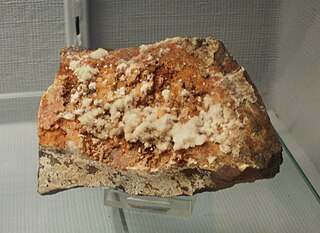
Rapidcreekite is a rare mineral with formula Ca2(SO4)(CO3)·4H2O. The mineral is white to colorless and occurs as groupings of acicular (needle-shaped) crystals. It was discovered in 1983 in northern Yukon, Canada, and described in 1986. Rapidcreekite is structurally and compositionally similar to gypsum.

Collinsite is a mineral with chemical formula Ca
2(Mg,Fe2+
)(PO
4)
2•2H
2O. It was discovered in British Columbia, Canada, and formally described in 1927. It was named in honor of William Henry Collins (1878–1937), director of the Geological Survey of Canada. There are three varieties of the mineral: magnesian collinsite, zincian collinsite, and strontian collinsite. The crystal structure consists of polyhedral chains linked by weak hydrogen bonds.
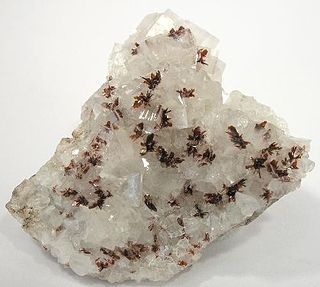
Ruizite is a sorosilicate mineral with formula Ca2Mn2Si4O11(OH)4·2H2O. It was discovered at the Christmas mine in Christmas, Arizona, and described in 1977. The mineral is named for discoverer Joe Ana Ruiz.

Ixiolite is an accessory oxide mineral found in granitic pegmatites. It is an oxide with the general chemical formula (Ta,Nb,Sn,Mn,Fe)4O8 or (Ta,Mn,Nb)O2.
Billwiseite is a very rare oxide mineral found at the pegmatite commonly referred to as "Stak Nala" located within a few hundred yards from the village of Toghla in the Stak Nala, Gilgit-Baltistan Pakistan. It has only been found as a coating on a single crystal of lepidolite. The sole rock containing Billwiseite is kept at the Royal Ontario Museum, catalogue number M5595.
Arakiite (IMA symbol: Ark) is a rare mineral with the formula (Zn,Mn2+)(Mn2+,Mg)12(Fe3+,Al)2(As3+O3)(As5+O4)2(OH)23. It is both arsenate and arsenite mineral, a combination that is rare in the world of minerals. Arakiite is stoichiometrically similar to hematolite. It is one of many rare minerals coming from the famous Långban manganese skarn deposit in Sweden. Other minerals bearing both arsenite and zinc include kraisslite and mcgovernite.
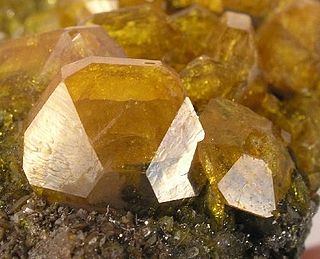
Sturmanite is a rare sulfate mineral with the chemical formula Ca6Fe3+2(SO4)2.5(B(OH)4)(OH)12 · 25 H2O. It crystallises in the tetragonal system and it has a Moh's hardness of 2.5. Sturmanite has a bright yellow to amber colour and falls in the ettringite group. It was named after Bozidar Darko Sturman (born 1937), Croatian-Canadian mineralogist and Curator Emeritus of Mineralogy, Royal Ontario Museum.
References
- ↑ Warr, L.N. (2021). "IMA–CNMNC approved mineral symbols". Mineralogical Magazine. 85 (3): 291–320. Bibcode:2021MinM...85..291W. doi: 10.1180/mgm.2021.43 . S2CID 235729616.
- ↑ "Bobfergusonite". Webmineral. Retrieved June 11, 2012.
- 1 2 3 4 5 6 "Bobfergusonite" (PDF). Handbook of Mineralogy. Mineral Data Publishing. Archived from the original (PDF) on July 16, 2012. Retrieved June 8, 2012.
- 1 2 3 4 "Bobfergusonite". Mindat. Retrieved June 8, 2012.
- ↑ Ercit, p. 600.
- ↑ Roberts, Andrew C. (1988). "New Mineral Names" (PDF). American Mineralogist. 73: 189–199.
- 1 2 Ercit, p. 605.
- 1 2 3 Ercit, p. 599.
- ↑ Hawthorne, Frank C. (December 1986). "Special Issue Dedicated to Robert Bury Ferguson" (PDF). Canadian Mineralogist. Mineralogical Association of Canada. 24: 597–598.
Bibliography
- Ercit, T. Scott; Anderson, Alan J.; Černý, Petr; Hawthorne, Frank C. (1986). "Bobfergusonite: A New Primary Phosphate Mineral from Cross Lake, Manitoba" (PDF). Canadian Mineralogist. Mineralogical Association of Canada. 24: 599–604.
- Ercit, T. Scott; Hawthorne, Frank C.; Černý, Petr (1986). "The Crystal Structure of Bobfergusonite" (PDF). Canadian Mineralogist. Mineralogical Association of Canada. 24: 605–614.